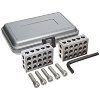So what kind of precision do you guys think is required to make a good silencer? I settle for 0.001" when making my baffles, end caps and spacers. Considering the conditions of some of the barrels I thread my cans on, the .001" margin is more than enough especially when I have a baffle bore of .040" to .080" greater than bullet diameter.
.001" is within the capability of some hobby lathes including the 12"x34" I bought from Grizzly ten years ago.
Ranb
.001" is within the capability of some hobby lathes including the 12"x34" I bought from Grizzly ten years ago.
Ranb






 !
!